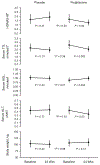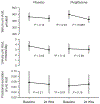Increased production and reduced urinary buffering of acid in uric acid stone formers is ameliorated by pioglitazone
- PMID: 30795852
- PMCID: PMC6478507
- DOI: 10.1016/j.kint.2018.11.024
Increased production and reduced urinary buffering of acid in uric acid stone formers is ameliorated by pioglitazone
Abstract
Idiopathic uric acid nephrolithiasis is characterized by an overly acidic urine pH caused by the combination of increased acid production and inadequate buffering of urinary protons by ammonia. A large proportion of uric acid stone formers exhibit features of the metabolic syndrome. We previously demonstrated that thiazolidinediones improved the urinary biochemical profile in an animal model of the metabolic syndrome. In this proof-of-concept study, we examined whether the thiazolidinedione pioglitazone can also ameliorate the overly acidic urine in uric acid stone formers. Thirty-six adults with idiopathic uric acid nephrolithiasis were randomized to pioglitazone 30 mg/day or matching placebo for 24 weeks. At baseline and study end, participants underwent collection of blood and 24-hour urine in an inpatient research unit while consuming a fixed metabolic diet, followed by assessment of the ammoniagenic response to an acute oral acid load. Twenty-eight participants completed the study. Pioglitazone treatment improved features of the metabolic syndrome. Pioglitazone also reduced net acid excretion and increased urine pH (5.37 to 5.59), the proportion of net acid excreted as ammonium, and ammonium excretion in response to an acute acid load, whereas these parameters were unchanged with placebo. Treatment of patients with idiopathic uric acid nephrolithiasis with pioglitazone for 24 weeks led to a reduction in the acid load presented to the kidney and a more robust ammoniagenesis and ammonium excretion, resulting in significantly higher urine pH. Future studies should consider the impact of this targeted therapy on uric acid stone formation.
Keywords: insulin resistance; metabolic syndrome; nephrolithiasis; pioglitazone; thiazolidinedione; uric acid.
Copyright © 2019 International Society of Nephrology. Published by Elsevier Inc. All rights reserved.
Conflict of interest statement
Disclosures:
The authors disclose no competing interests.
Figures



Comment in
-
Effect of thiazolidinedione therapy on the risk of uric acid stones.Kidney Int. 2019 May;95(5):1022-1024. doi: 10.1016/j.kint.2019.02.003. Kidney Int. 2019. PMID: 31010476
-
Re: Increased Production and Reduced Urinary Buffering of Acid in Uric Acid Stone Formers is Ameliorated by Pioglitazone.J Urol. 2019 Oct;202(4):655-656. doi: 10.1097/01.JU.0000577240.47597.4d. Epub 2019 Sep 6. J Urol. 2019. PMID: 31294658 No abstract available.
-
Pioglitazone and nephrolithiasis.Kidney Int. 2019 Aug;96(2):518-519. doi: 10.1016/j.kint.2019.04.015. Kidney Int. 2019. PMID: 31331471 No abstract available.
-
The authors reply.Kidney Int. 2019 Aug;96(2):519. doi: 10.1016/j.kint.2019.04.016. Kidney Int. 2019. PMID: 31331472 No abstract available.
-
Re: Increased Production and Reduced Urinary Buffering of Acid in Uric Acid Stone Formers is Ameliorated by Pioglitazone.Eur Urol. 2019 Dec;76(6):868-869. doi: 10.1016/j.eururo.2019.07.023. Epub 2019 Jul 24. Eur Urol. 2019. PMID: 31350069 No abstract available.
Similar articles
-
Renal ammonium excretion after an acute acid load: blunted response in uric acid stone formers but not in patients with type 2 diabetes.Am J Physiol Renal Physiol. 2013 Nov 15;305(10):F1498-503. doi: 10.1152/ajprenal.00374.2013. Epub 2013 Sep 11. Am J Physiol Renal Physiol. 2013. PMID: 24026180 Free PMC article.
-
Uric acid stone disease: lessons from recent human physiologic studies.Curr Opin Nephrol Hypertens. 2020 Jul;29(4):407-413. doi: 10.1097/MNH.0000000000000610. Curr Opin Nephrol Hypertens. 2020. PMID: 32398609 Review.
-
Net Acid Excretion and Urinary Organic Anions in Idiopathic Uric Acid Nephrolithiasis.Clin J Am Soc Nephrol. 2019 Mar 7;14(3):411-420. doi: 10.2215/CJN.10420818. Epub 2019 Feb 11. Clin J Am Soc Nephrol. 2019. PMID: 30745301 Free PMC article.
-
The metabolic syndrome and uric acid nephrolithiasis: novel features of renal manifestation of insulin resistance.Kidney Int. 2004 Feb;65(2):386-92. doi: 10.1111/j.1523-1755.2004.00386.x. Kidney Int. 2004. PMID: 14717908
-
Metabolic syndrome and uric acid nephrolithiasis.Semin Nephrol. 2008 Mar;28(2):174-80. doi: 10.1016/j.semnephrol.2008.01.010. Semin Nephrol. 2008. PMID: 18359398 Review.
Cited by
-
Pediatric adrenocortical carcinoma complicated by uric acid nephrolithiasis: a unique case report.BMC Urol. 2025 Apr 30;25(1):109. doi: 10.1186/s12894-025-01801-y. BMC Urol. 2025. PMID: 40307791 Free PMC article.
-
Exploration and Development of PPAR Modulators in Health and Disease: An Update of Clinical Evidence.Int J Mol Sci. 2019 Oct 11;20(20):5055. doi: 10.3390/ijms20205055. Int J Mol Sci. 2019. PMID: 31614690 Free PMC article. Review.
-
Narrative literature review of antidiabetic drugs' effect on hyperuricemia: elaborating actual data and mechanisms.Endocr Connect. 2024 May 10;13(6):e240070. doi: 10.1530/EC-24-0070. Print 2024 Jun 1. Endocr Connect. 2024. PMID: 38579756 Free PMC article. Review.
-
Pioglitazone-induced alterations of purine metabolism in healthy male subjects.Clin Transl Sci. 2024 May;17(5):e13834. doi: 10.1111/cts.13834. Clin Transl Sci. 2024. PMID: 38771175 Free PMC article.
-
Decreased Associated Risk of Gout in Diabetes Patients with Uric Acid Urolithiasis.J Clin Med. 2019 Sep 25;8(10):1536. doi: 10.3390/jcm8101536. J Clin Med. 2019. PMID: 31557790 Free PMC article.
References
-
- Shoag J, Tasian GE, Goldfarb DS, et al. The new epidemiology of nephrolithiasis. Advances in chronic kidney disease. 2015;22(4):273–278. - PubMed
-
- Daudon M, Knebelmann B. [Epidemiology of urolithiasis]. La Revue du praticien. 2011. ;61 (3):372–378. - PubMed
-
- Maalouf NM, Cameron MA, Moe OW, et al. Novel insights into the pathogenesis of uric acid nephrolithiasis. Curr Opin Nephrol Hypertens. 2004;13(2):181–189. - PubMed
Publication types
MeSH terms
Substances
Grants and funding
LinkOut - more resources
Full Text Sources
Other Literature Sources

